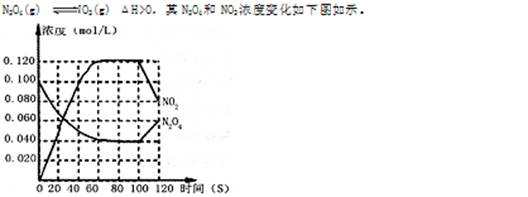问题
填空题
(8分)在一体积为1 L的容器中,通入一定量的N2 O4,在100℃时发生如下反应:

(1)在0-60s这段时间内,以N2O4表示的平均反应速率为 mol·L-1·s-1
(2)上述反应的平衡常数表达式为 ,升高温度K值 (填“增大"、“减小”或“不变”)
(3)反应进行到100s时,若有一项条件发生变化,变化的条件不可能是 (填选项序号)。
A.降低温度
B.通人氦气使其压强增大
C.又往容器中充入N2O4
D.使用催化剂
答案
(1)0.001
(2)K= 增大
增大
(3)BCD
(1) mol·L-1·s-1
mol·L-1·s-1
(2)由平衡常数的概念可知:K= ;由于△H>0,升温平衡正向移动,K增大
;由于△H>0,升温平衡正向移动,K增大
(3)由图像可知, 逐渐减小,而
逐渐减小,而 逐渐增大,平衡左移,故:
逐渐增大,平衡左移,故:
A:降温平衡左移,与图像相符
B:恒容下通入氩气,各物质浓度不变,正逆反应速度不变,平衡不发生移动,与图像不符
C:又往容器中充入N2O4, 瞬间增大,与图像不符
瞬间增大,与图像不符
D:使用催化剂,不影响平衡移动,各物质浓度不变,与图像不符
故BCD符合题意
